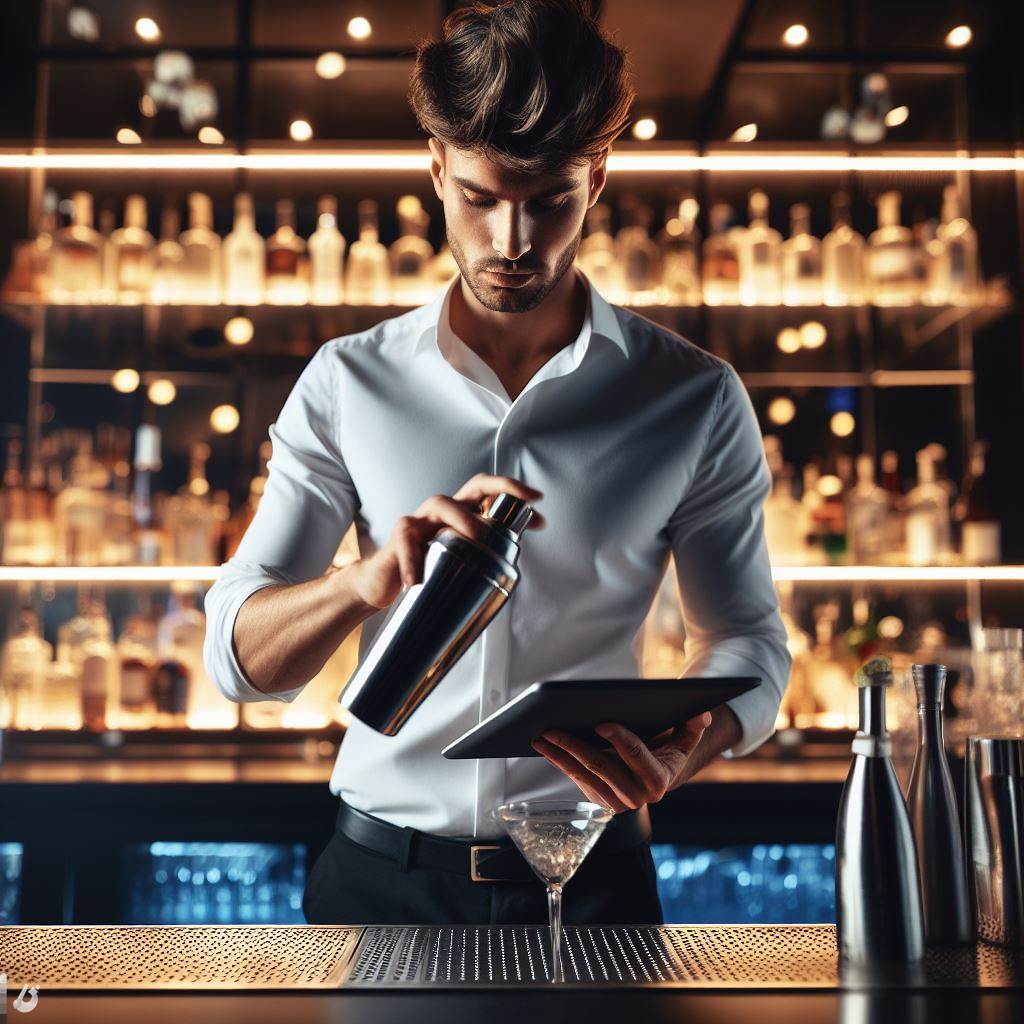Introduction
Briefly introduce the topic of bartending post-Covid in the US
The Covid-19 pandemic has deeply impacted various industries, and the bartending sector is no exception.
Bartenders have faced numerous challenges during this time, and it is crucial to examine the changes and adaptations happening in the post-Covid era.
This blog post aims to shed light on the implications of the pandemic on the bartending industry in the US.
Importance of discussing changes and adaptations in the industry
Firstly, we will explore how bartenders have had to navigate new safety protocols and guidelines to ensure the well-being of themselves and their customers.
This includes implementing social distancing measures, sanitization practices, and the use of personal protective equipment.
Secondly, the post-Covid era has witnessed a significant shift in consumer behavior and preferences.
We will delve into how bartenders are adapting to these changing demands by offering innovative and personalized experiences, such as craft cocktails for delivery or curbside pickup.
Additionally, the pandemic has accelerated the adoption of technology in the bartending industry.
We will examine the rise of contactless ordering and payment systems, as well as online platforms that provide virtual cocktail-making classes and tutorials.
Moreover, the impact of the pandemic on employment in the bartending sector cannot be overlooked.
We will discuss how bartenders have had to adapt to new job opportunities, such as private events or collaborations with local businesses.
Therefore, the post-Covid era has necessitated significant changes and adaptations in the bartending industry.
This blog post will explore the various aspects affected by the pandemic, highlighting the resilience and innovation demonstrated by bartenders in the US.
Pre-Covid Bartending Scene in the US
The pre-pandemic state of the bartending industry in the US
- Vibrant nightlife: The bartending industry in the US boasted a vibrant nightlife scene before the pandemic.
- Thriving bars and clubs: Bars and clubs were bustling with crowds, offering a wide variety of beverages.
- Socializing hubs: These establishments served as socializing hubs, where people gathered to connect and unwind.
- High demand for bartenders: The pre-pandemic bartending industry witnessed a high demand for skilled professionals.
- Diverse cocktail culture: Bartenders honed their craft in creating unique and innovative cocktails.
Typical job responsibilities and working conditions for bartenders
- Bartending skills: Bartenders were required to possess a wide range of skills, including mixing drinks and providing excellent customer service.
- Fast-paced environment: Bartenders often worked in fast-paced environments, handling multiple orders simultaneously.
- Teamwork and collaboration: Bartenders collaborated with fellow staff members to ensure smooth operations.
- Long hours and late shifts: Bartenders worked long hours, with most shifts extending late into the night.
- Customer interactions: They interacted with customers, offering recommendations, and creating personalized experiences.
Significance of the industry for the US economy
- Employment opportunities: The bartending industry provided numerous job opportunities, especially for younger individuals.
- Boosting tourism: Bars and clubs attracted tourists, contributing to the growth of the hospitality sector.
- Revenue generation: The industry generated substantial revenue through drink sales and cover charges.
- Supporting related businesses: Bartending establishments supported other businesses, such as suppliers and distributors.
- Economic multiplier effect: The money circulated within the industry had a multiplier effect, benefitting various sectors.
Most importantly, the pre-pandemic bartending scene in the US was characterized by a vibrant nightlife, thriving bars, and a diverse cocktail culture.
Bartenders held essential responsibilities, working in fast-paced environments and interacting with customers.
The industry played a significant role in the US economy, providing employment opportunities, boosting tourism, and generating revenue.
However, the outbreak of Covid-19 brought about significant changes and challenges for the bartending industry, requiring adaptations to ensure its survival and future success.
Read: Networking for Bartenders: US Bars and Bartender Associations
Impact of Covid-19 on Bartending
The pandemic brought significant changes to the bartending industry in the U.S.
- Bars and restaurants faced closures and restrictions, leading to a decline in business.
- Health and safety protocols, such as social distancing and sanitization, became mandatory.
- Customers were hesitant to visit bars, impacting overall sales and revenue.
- Event cancellations and limited capacity further affected bartenders’ job opportunities.
Bartenders faced numerous challenges during lockdowns and restrictions
- Job insecurity and fears of unemployment plagued bartenders as bars shut down.
- Many bartenders struggled to make ends meet, facing financial hardships.
- Adapting to virtual platforms for bartending classes and competitions became necessary.
- Mental health issues like isolation and loneliness affected bartenders during lockdowns.
The economic consequences and job loss in the bartending industry were substantial
- Thousands of bartenders lost their jobs due to bar closures and downsizing.
- The decline in tourism and travel further diminished bartending opportunities.
- The loss of income impacted bartenders’ financial stability and ability to support themselves.
- The industry experienced a decrease in taxes and revenue, affecting local economies.
As the pandemic wreaked havoc on the bartending industry, it became imperative for bartenders to adapt.
Read: Bartender Health & Wellness: Staying Fit in the US Scene
Transform Your Career Today
Unlock a personalized career strategy that drives real results. Get tailored advice and a roadmap designed just for you.
Start Now
Changes and Adaptations in Bartending Post-Covid
The Shift towards Outdoor and Outdoor Dining Options for Bars and Restaurants
- Bars and restaurants have been adapting to the post-Covid landscape by offering more outdoor seating.
- Outdoor dining provides customers with a safer environment with better ventilation and social distancing measures.
- Many bars have expanded their outdoor spaces, creating new seating areas and patios.
- Outdoor bars have become popular, offering customers a chance to enjoy beverages in the fresh air.
- Establishments have invested in outdoor heating and lighting to extend the usability of outdoor spaces during colder months.
The Adoption of Contactless Menus and Payment Methods
- To minimize touchpoints and potential spread of the virus, bartenders and restaurants have adopted contactless menus.
- QR codes are increasingly used so that customers can view menus on their smartphones.
- Contactless payment methods, such as Apple Pay and mobile wallets, have become more popular.
- Customers can now pay their bills without handing over their credit cards or touching the payment terminal.
- It allows for a more seamless and hygienic payment process while reducing physical contact.
The Use of Technology in Bartending: Mobile Ordering and Virtual Tastings
- Bartenders have embraced technology by offering mobile ordering options for customers.
- Customers can now order drinks directly from their smartphones, reducing the need for queues and physical contact at the bar.
- Virtual tastings have become a trend, where bartenders guide customers through tasting experiences via online platforms.
- These virtual experiences allow customers to learn about different cocktails and spirits from the comfort of their homes.
- Technology has opened up new possibilities for expanding the reach of bartending and creating unique experiences.
Enhanced Health and Safety Regulations Implemented for Bartenders and Customers
- Bartenders are required to wear masks and gloves while on duty to protect themselves and customers.
- Hand sanitizing stations have been placed at various points in bars and restaurants for easy access.
- Regular cleaning and disinfection of bar surfaces and utensils are carried out to maintain hygiene standards.
- Social distancing measures are enforced, with clear signage and markings to guide customers and maintain safe distances.
- Some bartenders have undergone additional training to stay updated on health and safety protocols and best practices.
Basically, the bartending industry has undergone significant changes and adaptations post-Covid.
Bars and restaurants have shifted towards offering more outdoor and outdoor dining options, embracing contactless menus and payment methods, utilizing technology for mobile ordering and virtual tastings, and implementing enhanced health and safety regulations.
These changes aim to create a safer and more enjoyable experience for both bartenders and customers amidst the ongoing pandemic.
Read: Impact of AI & Chatbots on CSRs in the United States
Rebuilding the Bartending Industry
Efforts to Support Bartenders and Revive the Industry
- Bartenders faced immense challenges post-Covid, prompting various efforts to support them.
- Organizations like the United States Bartenders’ Guild (USBG) provided financial aid and resources.
- The USBG established a Bartender Emergency Assistance Program to assist bartenders in need.
- Many states and local communities launched initiatives to provide grants and loans to struggling bartenders.
- Virtual events were organized to raise funds for bartenders, allowing them to meet their basic needs.
- Bartenders collaborated with local restaurants to provide cocktail delivery services, creating new revenue streams.
- Cocktail kits and online bartending courses were introduced to keep bartenders engaged and financially secure.
Importance of Community and Industry Collaborations
- Community support played a vital role in the revival of the bartending industry.
- Bartenders actively participated in community events, showcasing their skills and maintaining customer connections.
- Collaboration between bartenders, bar owners, and other industry professionals fostered resilience.
- Bartenders joined hands with local businesses to create unique experiences, attracting customers and promoting recovery.
- Industry collaborations promoted shared knowledge, helping bartenders adapt to changing expectations and demands.
- Bartenders utilized social media platforms to connect with colleagues, share ideas, and support each other.
- Professional associations organized forums and workshops to facilitate networking and collaboration.
Potential Long-Term Impacts on the Bartending Profession
- The post-Covid era brought significant changes to the bartending profession, some of which may have lasting effects.
- The expansion of delivery services and cocktail-to-go options may become permanent additions to the industry.
- Bartenders developed new skills in mixology and virtual customer engagement, offering enhanced services in the future.
- Virtual bartending events gained popularity, opening avenues for bartenders to explore global opportunities.
- The pandemic forced the industry to prioritize hygiene, leading to long-term changes in cleaning and sanitation practices.
- Online platforms introduced during Covid may continue to be utilized for skill-sharing and professional development.
- Bartenders learned to adapt to evolving customer preferences, paving the way for more innovative and diverse offerings.
In review, efforts to support bartenders and rebuild the industry post-Covid have been crucial.
Community support, industry collaborations, and the development of new skills have played significant roles in revival.
While the long-term impacts on the bartending profession remain to be seen, the industry’s ability to adapt and innovate ensures a promising future.
Read:Top U.S. Customer Service Conferences & Training Events
Learn More: Key Differences Between Concierge and Customer Service
Conclusion
In this blog post, we discussed several changes and adaptations in the US bartending industry post-Covid.
Throughout these challenging times, bartenders in the US have shown immense resilience and adaptability.
Looking ahead, there is a positive outlook for the future of bartending post-Covid in the US.
Bartenders will continue to navigate the changing landscape, ensuring the safety of patrons while delivering an exceptional experience.
With their creativity and passion, they will find innovative ways to connect with customers and provide top-notch service.
The Covid-19 pandemic has brought significant changes to the bartending industry in the US.
However, bartenders have proven their ability to adapt and overcome challenges.
As restrictions ease and the industry rebounds, bartenders will play a vital role in shaping the new normal for bars and restaurants.
With their unwavering dedication and commitment to their craft, bartenders will continue to create memorable experiences for their customers.
Cheers to the resilience and adaptability of bartenders, and the exciting future that lies ahead!
Showcase Your Business Today
Reach thousands of readers actively exploring professional services. Publish your business profile and grow your audience now.
Publish Now[E-Books for Sale]
The Big Book of 500 High-Paying Jobs in America: Unlock Your Earning Potential
$19.99 • 500 High-Paying Jobs • 330 pages
Explore 500 high-paying jobs in America and learn how to boost your career, earn more, and achieve success!
See All 500 High-Paying Jobs of this E-Book
1001 Professions Without a Degree: High-Paying American Jobs You Can Start Now
$19.99 • 1001 Professions Without a Degree • 174 pages
Discover 1001 high-paying jobs without a degree! Unlock career tips, skills, and success strategies for just $19.99!




